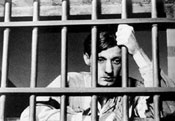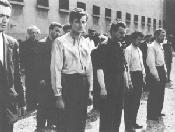FILM NOTES
FILM NOTES INDEX
NYS WRITERS INSTITUTE
HOME PAGE

 A Man Escaped
A Man Escaped
[UN CONDAMNÉ À MORT S'EST ÉSCHAPPÉ]
(France, 1956, 99 minutes, b&w, 35mm)
(In French with English subtitles)
Directed by Robert Bresson
Cast:
François Leterrier . . . . . . . . . . Lieutenant Fontaine
Charles le Clainche . . . . . . . . . . François Jost
Maurice Beerblock . . . . . . . . . .Blanchet
Roland Monod . . . . . . . . . .Le Pasteur
The
following film notes were prepared for the New York State Writers
Institute by Kevin Jack Hagopian, Senior Lecturer in Media Studies
at Pennsylvania State University:
The experience of war, it is said, is limited to what the combatant can sense directly around him or her. It is a tightly circumscribed world of rigorous physical reality, with little space for reflection. Robert Bresson's A Man Escaped is an agonizing exploration of this highly-focused reality. It is a film that imagines the longest night of a man's life, when every object he sees holds death in its merest sound, when a squeak or a rattle can kill him.
A Man Escaped is based on the memoirs of Andre Devigny, imprisoned in France during World War II by the Gestapo for his activities with the French Resistance. In an effort to preserve the authenticity of Devigny's account, Bresson shot A Man Escaped in Fort Montluc prison in Lyons, where Devigny's imprisonment occurred. Indeed, the prison had actually preserved the ropes and hooks Devigny used in his escape attempt, and Bresson copied these assiduously -- they become among the most striking props you will ever see. Though Devigny is called Fontaine in the film, what follows is so close to his experiences that the film deserves its extraordinary foreword by Devigny: "This story is true. I give it as it is, without embellishment." Bresson had the moral right to claim such authenticity: he, too, had been imprisoned by the Germans during the war.
 The way that Bresson recreates war's physically limited view is through sound; A Man Escaped could even be said to be about sound. Because Fontaine must live in punishing silence, and because the view from his little cell is so limited, he can only construct his cognitive map of the world he cannot see through the sounds, many of them painfully small, which are so infrequently scattered about him. Those sounds begin to expand and mutate inside his head, and inside ours, becoming inordinately important, freighted with mortal danger one moment, blissful hope the next.
The way that Bresson recreates war's physically limited view is through sound; A Man Escaped could even be said to be about sound. Because Fontaine must live in punishing silence, and because the view from his little cell is so limited, he can only construct his cognitive map of the world he cannot see through the sounds, many of them painfully small, which are so infrequently scattered about him. Those sounds begin to expand and mutate inside his head, and inside ours, becoming inordinately important, freighted with mortal danger one moment, blissful hope the next.
At first, there is no coherent analysis to be made of these sounds; Fontaine simply tries to put them together to decipher the goings-on outside his immediate space. The film's opening sequence sets the tone for this rigorous limitation of information, and it is justifiably famous as one of the most understated sequences in a film whose entire aesthetic is based on understatement. But soon, a plan for escape formulates itself in the fevered brain of the indefatigable Fontaine. Then, one question only occurs to him, and to us, as we listen fixedly to every sound throughout the rest of the film: can they hear me?
Bresson took exquisite care with all of his films; he completed only 14 features in his lifetime. A Man Escaped was the first film for which he wrote the entire script without assistance, and like each of his films, it is marked with his fanatical attention to detail, and to truth, which Bresson felt was not only within the grasp of the filmmaker, but a moral demand the art of film made on all who would practice it. Ascetic and idealistic, Bresson was one of the relatively few filmmakers of his generation who would be embraced by the cinematic revolutionists of the French New Wave. One of the greatest of the New Wave filmmakers was Eric Rohmer, who was a critic for the influential film journal Cahiers du Cinema when A Man Escaped was released. Rohmer entitled his review of the film "The Miracle of Objects," because, although the sounds in the film are "explained" with scrupulous fidelity to their sources, yet each sound also has an extraordinary function in the life of the desperate Fontaine.
The truly great wartime prison camp films are few. Billy Wilder's Stalag 17, Jean Renoir's The Grand Illusion, Ousmane Sembene's Camp de Thiaroye, David Lean's The Bridge on the River Kwai, Basil Dearden's The Captive Heart. Each of these captures the longing for home, the turning upside down of military order, and the strange camaraderie that grows up between prisoners, and sometimes even between prisoners and guards. But these are finally films about community, about shared suffering. Only A Man Escaped deals in the deprivation of the soul that a man alone undergoes -- and that is perhaps the greatest violence of incarceration. In the end, Fontaine must make the most crucial decision that a man starved for human society can possibly face: can I trust another person? Whether in Fort Montluc or Guantanamo, the experience of solitary confinement in wartime purposefully seeks to tear away the very essence of humanity in the service of defeating the enemy. Call it "morale," but it is something deeper: the knowledge that we obtain sustenance from one anothers' presence, and that without that presence, we are uncertain, afraid, and finally, silent.
— Kevin Hagopian, Penn State University
For additional information, contact the Writers Institute at 518-442-5620 or online at https://www.albany.edu/writers-inst.